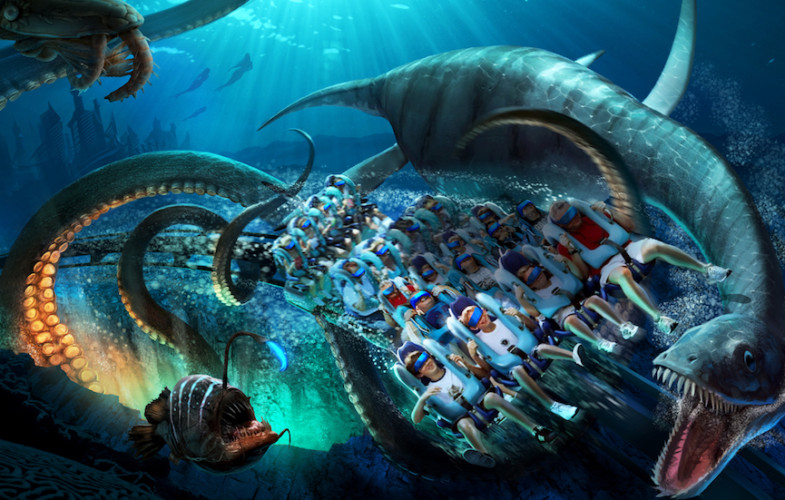KRAKEN, a 17-year-old rollercoaster an amusement park in Florida, at SeaWorld Orlando, reopened after several months of refurbishment in June. That, in itself, is odd. The normal fate of rides that are older is demolition and replacement by new ones offering new thrills. More unusual still is that Kraken, though it hadn’t undergone any upgrade had customers queuing to get on it as though it were a brand new offering. Which, in a sense, it was.
 SeaWorld Orlando is the latest in a series of parks to turn to virtual reality (VR) to recycle rollercoasters of days past.
SeaWorld Orlando is the latest in a series of parks to turn to virtual reality (VR) to recycle rollercoasters of days past.
Building a new ride is pricey for a big attraction like SeaWorld. For parks, with budgets that are low, it may be an bet. VR has given parks an opportunity to breathe new life into old rides. Adding VR into a rollercoaster does, however, present challenges beyond those involved when the headset wearer is either stationary or using his own muscles to maneuver. Is crucial. Get it wrong and the result is nausea. Yet, when executed properly, the pairing of rollercoasters and VR, two things that can by themselves, be nauseating experiences helps reduce the chance of sickness.
 The extensive remodeling of the thrill ride includes a brand new custom digital overlay, creating a virtual reality adventure that connects the ride’s mechanics to a visual and auditory experience. The Virtual Reality VR headsets will be tethered to each seat on the coaster, giving guests the option of experiencing Kraken in its original form or as a virtual attraction. The VR goggles act as a virtual submarine, submerging riders deep under the sea as they embark on a mission alongside both extinct and legendary sea creatures. The new story told throughout the ride is tied to the nearby Journey To Atlantis attraction, which was also recently updated.
The extensive remodeling of the thrill ride includes a brand new custom digital overlay, creating a virtual reality adventure that connects the ride’s mechanics to a visual and auditory experience. The Virtual Reality VR headsets will be tethered to each seat on the coaster, giving guests the option of experiencing Kraken in its original form or as a virtual attraction. The VR goggles act as a virtual submarine, submerging riders deep under the sea as they embark on a mission alongside both extinct and legendary sea creatures. The new story told throughout the ride is tied to the nearby Journey To Atlantis attraction, which was also recently updated.
One reason behind VR-induced nausea is high latency–too long a delay between users moving their heads (and consequently their anticipated view of the virtual world) and the headset’s response to that movement. In the 1990s, when VR was in its infancy latency was common. Though, latency has diminished, minimising the chance of nausea, as the technology has improved.
But not eliminating it. For a second source is of cue conflict in VR: the eyes seeing movement that the body is not currently experiencing. And this is something rollercoasters will help by providing the missing experience of movement resolve. Match the signal from the headset to the coaster’s motion and the brain’s inputs will also match.Amusement Park Rides
That match, however, must be exact. A small discrepancy between the image and the coaster’s motion of the headset may have a effect. To guarantee perfect correspondence, VR firms like Figment Productions, a British firm that worked on the new Kraken ride, map the entire track using devices called inertial measurement units (IMUs) prior to the visuals are created.
These IMUs are sophisticated versions of the widgets which smartphones and tablet computers use to work out which way up the screen display should be. Figment’s boss, Simon Reveley, says because their ability to detect changes is similar to that of a blindfolded human being — which is exactly what someone is the company chose these detectors. IMUs are adept at sensing alterations in course and movement, while being poor at enrolling speed or distance travelled.
Once the IMU map has been made, video can be created to match it. Kraken’s cars each are fitted with IMUs that compare its behavior during a genuine run to be sure everything stays in synchrony. Any discrepancy is used to adjust the rate of the video, to be able to preserve verisimilitude.
The VR Virtual Reality enhancement of rides is unlikely to remain limited to rollercoasters. Six Flags, among the world companies, is currently experimenting with adding VR to drop towers–devices where the rider experiences seconds of. When they strap in for their rides Park visitors should expect to don headsets.
 Translate
Translate


